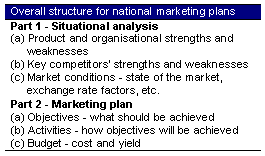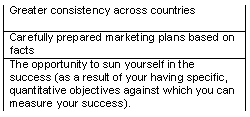|
You can build an international marketing plan in three stages:

This means that, before you can expect to know about local country plans, you have to communicate what they can expect from you and what demands you are going to make of them.
Among other things, you should tell them what products to market, what marketing and promotional materials you are going to provide, in which international events you will participate, etc.
Cross-border concurrence
One of the objectives of an international marketing plan is to get an overview of the sales and marketing effort. That's why national marketing plans should have the same structure -- to make the ensuing compilation and comparison easier.
 How do you ensure you get the same structure from all countries? Try to give your international partners fill-in forms. This also means that your country managers and international partners are relieved from having to write "War and Peace" -- they can simply fill in a few forms for the benefit of all parties.
How do you ensure you get the same structure from all countries? Try to give your international partners fill-in forms. This also means that your country managers and international partners are relieved from having to write "War and Peace" -- they can simply fill in a few forms for the benefit of all parties.
Take a leaf out of the finance department's book
Part Two of the marketing plan starts with creating both qualitative and quantitative objectives. For that purpose, you can learn a lot from your finance colleagues' many ratios like gross margin %, return on net capital, break-even, etc.
Sharply contrasting this is the marketing plan that merely contains sales and marketing objectives. Many are content with this, since it's "all about sales at the end of the day". But why would you accept budgets that are merely the outcome of sticking a finger in the air? You're much better off uncovering the deeper reasons for sales figures.
International Marketing Planning with Market Mapping
The Cross-border Market Map technique is well cut out to facilitate international marketing planning, because its basis is the set of obstacles you must overcome to get a sale.
For any market share you have, you can break it into four, more manageable sub-shares: Awareness share, Product fit, Supplier fit, and Competitiveness. When you multiply these sub-marketshares, you end up with your total market share.
This means you can ask local country managers or partners to create objectives for these key sub-shares. Consequently, you can make a much more qualified judgement about their estimates of market sizes, market shares, and sales progress.
Customer satisfaction
Another key indicator for your international marketing plan is customer satisfaction. As you probably know, it's both easier and more profitable to do business with existing customers than new ones.
By knowing your customers' satisfaction levels you can both anticipate their behaviour, loyalty, and likelihood of buying from you in future, but you can also deal proactively with germinating customer dissatisfaction.
Start out carefully
If this is the first time you implement structured international marketing plans, start softly without too many key indicators. We recommend using the Cross-border Market Map for analysing how to get more new customers and customer satisfaction analyses for repeat business.
You end up with five key indicators:
 Reaping the rewards
It may take some time and resources, but you can usually get these five key indicators "without breaking the bank".
Reaping the rewards
It may take some time and resources, but you can usually get these five key indicators "without breaking the bank".
By taking international marketing planning seriously, and applying a methodical framework, you achieve three useful things:
 ... and you get recognition for achievements beyond just "making brochures".
... and you get recognition for achievements beyond just "making brochures".
If you'd like to know more about how we might be able to help you get the figures, just call us now at 0870 745 6899 or fill in the form below to arrange an initial free-of-charge consultation:
Get more info now:
[More about LEC's Cross-border Market Mapô Analysis]
Go to overview of LEC Techniques
Go to LEC Cases in point
|
|

